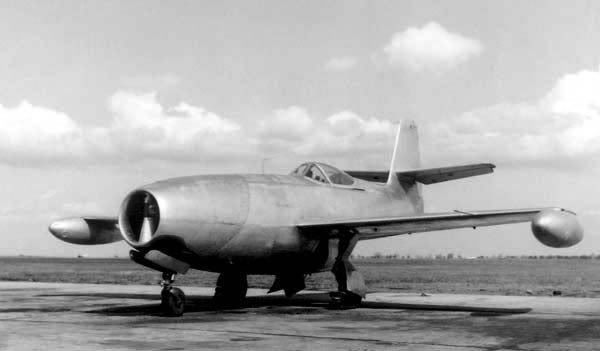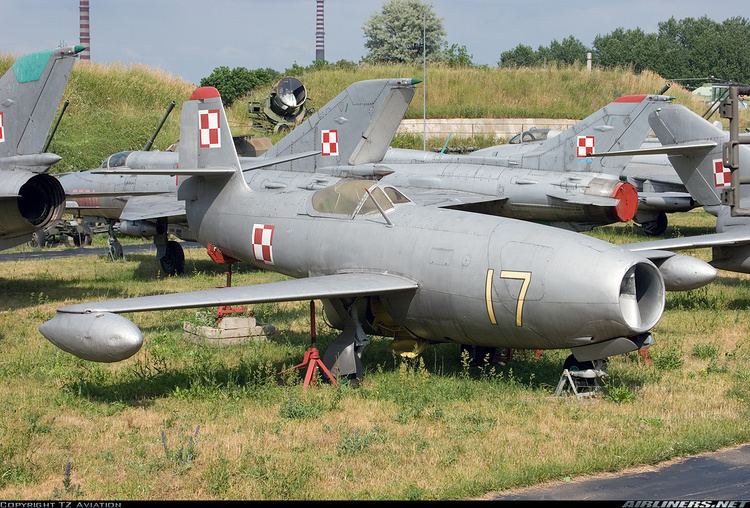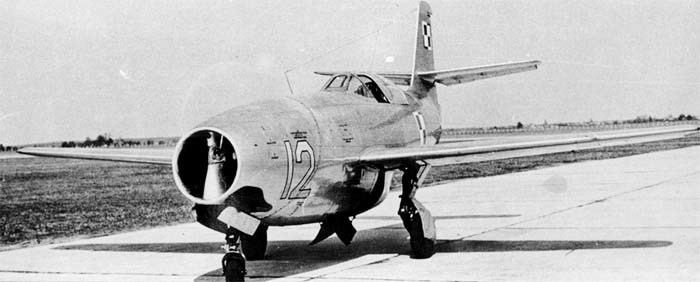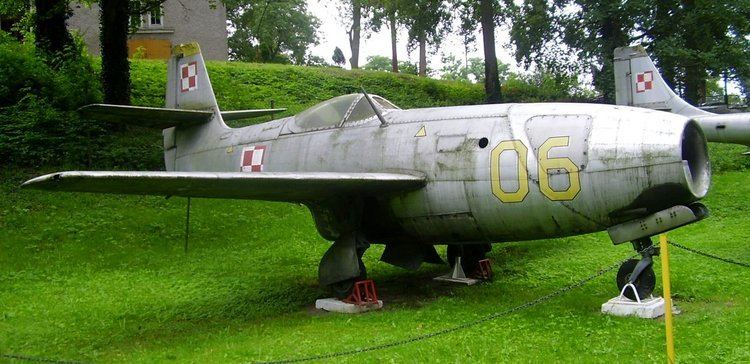Top speed 923 km/h Wingspan 8.73 m Weight 1,980 kg First flight July 8, 1947 | Range 1,400 km Length 8.13 m | |
 | ||
Yakovlev yak 23 type 28 nato code name flora
The Yakovlev Yak-23 (in Russian Як-23, USAF/DoD reporting name Type 28), NATO reporting name Flora) was an early Soviet jet fighter with a straight wing. It was developed from the Yak-17 in the late 1940s and used a reverse-engineered copy of a British engine. It was not built in large numbers as it was inferior in performance to the swept-wing Mikoyan-Gurevich MiG-15. Many Yak-23s were exported to the Warsaw Pact nations and remained in service for most of the 1950s, although some were still in use a decade later.
Contents
- Yakovlev yak 23 type 28 nato code name flora
- Development and description
- Operational history
- US testing
- Records
- Variants
- Operators
- Specifications Yak 23
- References

Development and description

On 11 March 1947, the Council of People's Commissars ordered several design bureaux (OKB), included that of Alexander Yakovlev, to develop a single-seat, straight-winged jet fighter to be equipped with a single British Rolls-Royce Nene or Rolls-Royce Derwent turbojet engine. The aircraft should have a maximum speed of 950 kilometers per hour (590 mph) at sea level and a speed of 1,000 km/h (621 mph) at an altitude of 5,000 meters (16,400 ft). It should be able to climb to that altitude in 3.5 minutes or less and should have a maximum range of no less than 1,200 kilometers (750 mi). Alexander Yakovlev decided to develop two designs, the Yakovlev Yak-25 in accordance with the Ministry's order and a lightweight, more agile aircraft (the Yak-23) in the hopes that one or the other would win an order from the Ministry. Yakovlev's decision was a risky one as it could be construed as unauthorized use of state monies if discovered, which could have landed Yakovlev in a lot of trouble.

To minimize risk, the new aircraft used the same "pod-and-boom" layout as the earlier Yak-17 fighter, but the metal fuselage was redesigned as a semi-monocoque structure with the single-seat, unpressurized cockpit and its teardrop-shaped canopy positioned just above the trailing edge of the wing. Not coincidentally, this was also above the exhaust of the 1,590-kilogram-force (15.6 kN; 3,500 lbf) centrifugal-flow Klimov RD-500 engine, an unlicensed copy of the Derwent V. Fitted with tricycle landing gear, the main landing gear retracted inwards into the fuselage while the nose gear retracted forwards. Unlike the installation in the Yak-17, the Yak-23's forward landing gear was flush with the fuselage when retracted. The laminar-flow, two-spar, wing was mounted in the middle of the fuselage. It was equipped with slotted flaps and ailerons and had a modest 3° 30' dihedral. The horizontal stabilizers had 5° of dihedral. The pilot was protected by a bulletproof windscreen and the armored back of the ejection seat. The Yak-23 was equipped with five non-self-sealing fuel tanks in the fuselage that had a total capacity of 910 liters (200 imp gal; 240 U.S. gal) of fuel. In addition it could carry a pair of 195-liter (43 imp gal; 52 U.S. gal) drop tanks under the wingtips. The fighter was armed with two 23-millimeter (0.9 in) Nudelman-Rikhter NR-23 autocannon, each with 90 rounds.

Two prototypes and a static-test airframe were ordered and the aircraft first flew on 8 July 1947 with the Hero of the Soviet Union, Lieutenant Colonel Mikhail Ivanov, at the controls. While still involved in its manufacturer's flight testing, the first prototype participated in the flypast at Tushino Airfield on 3 August. The Yakovlev OKB concluded its testing on 24 September and turned over the second prototype for state acceptance trials on 22 October. Although the Yak-23 was accepted for series production, it was criticized of heavy aileron and rudder forces, lack of cockpit pressurization and heating and ventilation, protection for the pilot and weak armament. The test pilots did praise it as highly maneuverable, with a good acceleration and takeoff and climb capabilities thanks to a high thrust-to-weight ratio. The second prototype was modified afterwards to address some of these issues and successfully tested again in 1948.
Operational history
The first aircraft were produced in a factory in Tbilisi in October 1949. In late 1949 they entered Soviet air force service. The Yak-23 was quickly replaced in the Soviet service with the more complicated swept-wing MiG-15, which offered superior performance. In all, only 316 Yak-23 aircraft were built before production ended in 1951. Apart from the fighter there were two trainer versions of the Yak-23 which were built in small numbers. The Yak-23UTI two-seat trainer which appears to have had the unusual arrangement of having the instructor seated in front of the student, and the Yak-23DC trainer which was produced in Romania.
Small numbers of Yak-23s were exported to Czechoslovakia (20 from 1949, named S-101), Bulgaria (from 1949), Poland (about 100, from 1950), Romania (62, from 1951). Poland and Czechoslovakia acquired licenses for the aircraft, but built the superior MiG-15 instead. Yak-23s were withdrawn by the late 1950s, except in Romania which used them for another decade.
US testing
A single Yak-23 was acquired by US intelligence, via Yugoslavia, in November 1953. It was a Romanian Yak-23 flown by Mihail Diaconu who defected with it. The aircraft arrived disassembled, and was shipped to the Air Force Test and Evaluation Center at Wright Field near Dayton, Ohio. It was reassembled and made operational for several flight tests, during which time it was disguised with U.S. markings. Efforts were made to keep the aircraft's identity secret, and it was flown only in the early morning. On one occasion it was passed on the runway by a formation of F-86's, whose pilots inquired as to the plane's identity. A story was conceived that the aircraft was a Bell X-5, which had a similar layout. At the completion of design and flight evaluations the aircraft was again disassembled and shipped quietly back to Yugoslavia in its original paint scheme.
Records
On September 21, 1957, the Polish pilot Andrzej Abłamowicz set two FAI world records in the Yak-23 with civilian markings SP-GLK, in its weight class, climbing to 3,000 m (9,843 ft) in 119 seconds (4,962.6 ft/min) and to 6,000 m (19,685 ft) in 197 seconds (5,995.4 ft/min). This plane was withdrawn in 1961.
Variants
Operators
Bulgaria
Czechoslovakia
Poland
Romania
Soviet Union
Specifications (Yak-23)
Data from The Complete Book of Fighters
General characteristics
Performance
Armament
